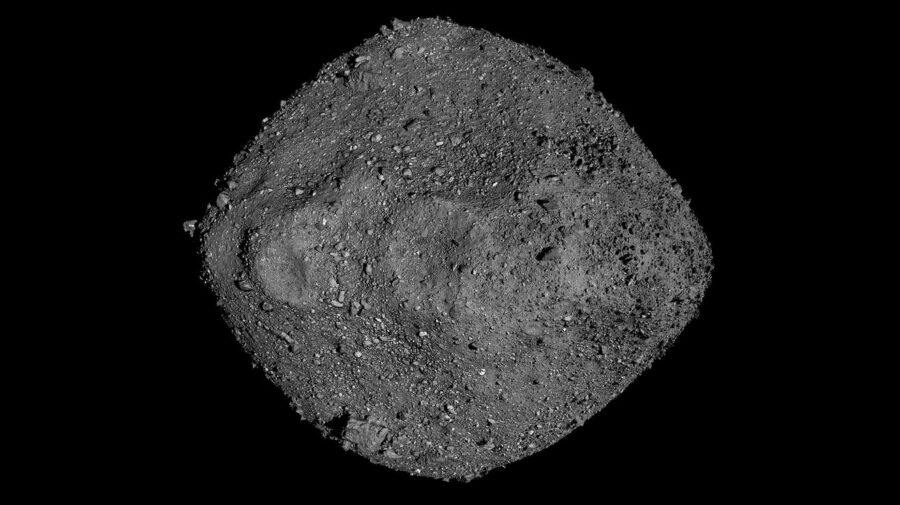
NASA GSFC / University of Arizona
Small asteroids are called rubble piles because they come in pieces, but close-up observations show the near-Earth asteroid 101955 Bennu is far from a random accumulation of interplanetary debris. Scientists analyzing data from NASA’s Osiris-REX spacecraft say they’ve found evidence it has an inner shell: a compacted layer a few meters thick made of small particles. The results will appear in Icarus.
Most asteroids larger than tens of kilometers appear as single bodies, held together by gravity despite cracks and impacts. However, asteroids in the kilometer range or smaller are more often loose aggregations of smaller objects. The latter, so-called “rubble piles,” often have a low overall density and appear to be porous. Examples include sub-km near-Earth asteroid 25143 Itokawa, visited by the Japanese Hayabusa probe and the 900-meter asteroid 162173 Ryugu, visited by Hayabusa2.
These past visits have yielded some signs of subsurface layers, but study of 490-meter Bennu, also a rubble-pile asteroid, is yielding evidence of something more comprehensive. Osiris-REX, launched in 2016, began delivering high-resolution images to Earth when it approached the asteroid in late 2018.
Soon after those details began emerging, Edward "Beau" Bierhaus (Lockheed Martin) saw something odd: “The texture contrast [between] crater interiors popped out to be very different depending on size,” he noted. The centers of craters less than 25 meters wide looked smoother than the rough surrounding terrain, whereas larger craters were just as rough inside as out.
At the time, though, Bierhaus couldn’t dig deeper. As a member of the Osiris-REX science team and scientist for the touch-and-go sample collector, he was preoccupied with grabbing a sample of Bennu on October 20, 2020. (That sample is on its way back to Earth, set to arrive on September 24th.)
“[Only] after OSIRIS-REx left Bennu and headed back to Earth did I have an opportunity to sit back and think about this observation in more detail,” Bierhaus says. He gathered a team that eventually included 14 other scientists to figure out what was going on inside Bennu.
On the Surface
The group started with visual examination of the Osiris-REX images of Bennu. “The particles inside the smaller craters looked smaller than those in the larger ones,” says Bierhaus. This difference gave the visual impression that the smaller craters’ interiors were smoother.
More precise measurements came from the laser altimeter supplied by the Canadian Space Agency, which provided “extraordinary data,” Bierhaus says. The instrument mapped surface details down to 5 centimeters (2 inches) across, and recorded heights with centimeter resolution. That data enabled them to measure surface roughness as well as particle sizes in hundreds of craters, confirming the trend of smooth interiors of smaller craters.
Additionally, spectroscopy revealed color differences not discernible to the human eye, showing that the smaller craters reflected more red light than the larger ones. Their redder colors indicate fresher material that has been more recently excavated.
Because the changes in smoothness occur for craters smaller than 25 meters, and because those craters tend to be excavate 1 to 4 meters, the team inferred that the subsurface layer extends down 1 to 4 meters.
The video of OSIRIS-Rex’s sampling of Bennu provides direct confirmation of the layer’s existence. A video camera was attached to the sampling arm and recorded a frame every second during the October 20, 2020, sampling event. The event included shooting a burst of nitrogen gas into the surface, which then puffed particles into the sampler.
Not only did the particles dramatically overflow the sampler, but images show that the sampling arm itself penetrated about a half meter into the exposed subsurface layer at the floor of the crater. Analysis of the images showed that the arm encountered smaller particles as it went deeper. This result suggests that it had penetrated only part-way into the subsurface layer; the whole subsurface layer must be more than a meter thick.
Bennu has little of the fine dust in which lunar astronauts famously left their footprints half a century ago, because such tiny grains easily drift away from the little asteroid. But the world’s gravity more easily holds onto larger particles, which dominate the surface.
However, microimpacts and other events, such as when the Sun’s heat fractures the surface, produce smaller surface particles. These particles may float away — or they may fall between the gaps of the larger surface rocks.
Earlier, scientists had attributed large boulders of a meter or more on Bennu’s surface to the Brazil Nut effect, in which shaking causes large particles to rise to the top of a collection. Looking below the surface of Bennu has revealed the other side of the Brazil Nut effect: the settling of smaller particles by eons of shaking to form a layer inside the asteroid.
Over hundreds of thousands of years, this process builds up a subsurface layer of smaller particles around the entire asteroid. Even when a large-enough impact ejects the subsurface layer at one location, the process will naturally restart.
“The analyses provide observational evidence that Bennu could have a strong global subsurface layer consisting of fine particles,” says planetary scientist Yun Zhang (University of Michigan), who was not involved in the study. She adds that these results will not only help researchers understand the formation and evolution of rubble-pile asteroids, they’ll also provide context for the sample from Bennu as it returns to Earth for analysis.
 1
1









Comments
accurateye
September 6, 2023 at 7:20 pm
One might anticipate larger particles on and near the surface with smaller particles sifted inward due to acoustic and mechanical vibration, thermal deformation and other forces – much the same as particle segregation in terrestrial gravel/sand mixtures.
You must be logged in to post a comment.
You must be logged in to post a comment.